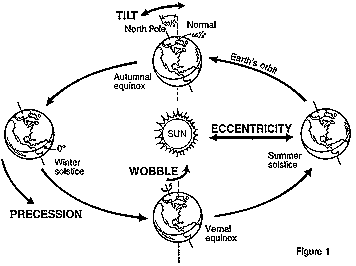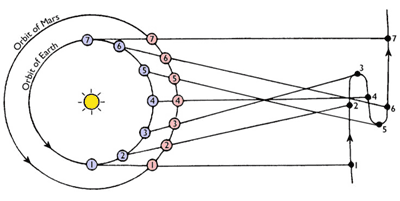Nicholaus Copernicus was a polish mathematician and astronomer who was also a man of the church. Though he was not the first, Copernicus proposed an idea that would, eventually, revolutionize the entire field of astronomy as well as our understanding the solar system; he proposed a heliocentric model of the solar system. Dissatisfied with the geocentric model proposed by Pytolemy, Copernicus yearned for a model of the solar system that would please him, not with respect to accuracy, but with respect to simplicity and beauty. Copernicus ventured to create a system that he could intuitively feel was correct, a system where he could see the beauty of God's work.
Copernicus' model relies on several key ideas:
The planets revolve around the Sun, with Earth making a complete cycle in one year:
The most jarring and perhaps most important change that Copernicus made to the model of the solar system was making it heliocentric, that is he believed that it was Sun centered not Earth centered. As if only to add salt to the metaphorical wound, not only did Copernicus proclaim that the Earth was not special enough to be the center of the system, but that it was just like all the other planets and that they all revolved around the Sun.
The Earth has a daily rotation around its tilted axis:
As opposed to the common belief at the time, that the starry sky revolved around the Earth to create night and day, Copernicus asserted that the actual cause was the rotation of the Earth around its axis with the stars as a fixed background. Furthermore he believed that the axis of the Earth was not parallel to a tangent of the Sun, but rather that it was tilted towards or away from the Sun and that the axis tilt would also make one full revolution per year.
The motions of the heavenly bodies are circular:
Copernicus
believed that all the orbits of the heavenly bodies had to be circular.
Circles are in some sense a perfect shape, circles have no beginning
nor end and in this way they are eternal. As a man of God, Copernicus
would not have himself believe that God would create anything less than
such eternal perfection. Ironically, this belief would become one of the
root causes for the inaccuracies in Copernicus' calculations and would
make the acceptance of his ideas much more difficult. This is not to
look down on Copernicus of course, in some sense it may have been
necessary to accept this assumption; for it would have been unlikely for
the Church to allow blasphemy in the form of elliptical orbits.
Ultimately, Copernicus lived in an age where proving his ideas would prove to be impossible. Not only were the tools and technology lacking, the philosophical implications of his work were so outrageous that he was heavily reluctant to share what work he had. The geocentric model of the solar system was so ingrained in the minds of the educated public that even suggesting otherwise was almost surely a one way ticket to ridicule.
This of course, is not to say that there was no evidence to support Copernicus' claims. In fact, from the modern perspective, there is much more good in Copernicus' heliocentric model than the bad, however the physics at the time was not sophisticated enough to register relative correctness of his assertions.
Copernicus' belief in the Sun centered system with an orbiting Earth had the very enticing benefit of easily explaining the retrograde motion of the planets, a mysterious phenomenon that was torturously worked into the Pytolemic model using complex and very specific epicycles. Retrograde motion is simply when another heavenly body, from the perspective of a viewer on Earth, reverses the direction of its orbit. In the heliocentric system if the planets orbit at different speeds, then whenever one passes another, the slower one would appear to experience retrograde motion from the perspective of the faster one. Furthermore, the tilt of Earth's axis while revolving around the Sun would explain the seasons, since the area of the Earth tilted towards the Sun experiences more sunlight during the day, it is warmer producing summer and visa versa for winter.
In the end, Copernicus decided that these benefits alone were not enough to warrant a publication of his ideas, and it was not until a student of his named Rheticus insistently urged him to release his work that it would finally be seen by the eyes of the public. Unfortunately, this most important piece of knowledge that Copernicus imparted upon the world [in the form of the book De Revolutionibus] would fly so far below the radar it was practically a resident of the Marianas Trench. This may in part be due to the fact that Copernicus' model did not provide significantly improved results in terms of accuracy over the Pytolemic model, as he stubbornly held onto the idea of epicycles. This led to many academics passing off Copernicus' system as a mathematical tool as opposed to a physical reality. It would not be until hundreds of years later that the heliocentric model would come to be accepted.
Though Copernicus started the revolution towards heliocentrism by being the first individual to combine both the mathematics and the physics of such a system, the ideas he incorporated into his model were actually much older. The idea that the Earth was not stationary in the universe was first
hatched by Philolaus of Magna Graecia, though he did not specifically
believe in a heliocentric system. Before Philolaus the was Aristarchus of Samos, the earliest recorded individual to propose a heliocentric system, back in the days of Aristotle who naturally and promptly stomped the idea back into the supposedly stationary Earth. Furthermore, Aristarchus had a surprisingly significant following so it is probable that at least a few of them worked on the heliocentric system; unfortunately, if such work ever existed, it has long been lost. Beyond the ancient astronomers, a number of Medieval astronomers also toyed with similar ideas as Copernicus including Nicholas of Cusa, who queried whether or not the Sun was the center of the universe. Another was Nicole Oresme, who was also a man of the Church. He believed that the Earth had an axial rotation to cause night and day prior to Copernicus. Even more generally, outside of Europe, there were quite a few astronomers in Indian and Islamic regions who worked on results involving the motion of the Earth and position of the planets. Given the surprisingly large number of individuals who worked on heliocentrism before Copernicus, it is almost miraculous that it took so long for the idea to catch on. Such is the power of the inertia of belief.
In the end, what is likely the most important belief held by Copernicus was his belief in the Sun being the unmoving center of the Solar System. This fundamental idea was the main concept of Copernicus' system, and without a solid foundation he could not have put his entire model together. It was his precise fusion of mathematics and physics that really pushed the idea of heliocentrism, giving it the initial jolt of energy needed to eventually overtake geocentrism. The spinning of Earth around its axis, though interesting in itself, is not fundamentally a key part of heliocentrism, furthermore, the Earth orbiting the Sun like the other planets is not a hard leap to make, once you assume that the Sun is the center. Ultimately, it is the foundational idea that should be most important, the other two points are interesting and related but are not as vital. Fundamentally the importance is in the name of system itself, helio meaning Sun and centric meaning centered at.
Resources:
-http://en.wikipedia.org/wiki/Philolaus
-http://en.wikipedia.org/wiki/Georg_Joachim_Rheticus
-http://en.wikipedia.org/wiki/Copernican_heliocentrism
-http://starchild.gsfc.nasa.gov/docs/StarChild/whos_who_level2/copernicus.html
-http://en.wikipedia.org/wiki/Heliocentrism
-http://www.space.com/15684-nicolaus-copernicus.html
-http://astronomy.nju.edu.cn/~lixd/GA/AT4/AT402/HTML/AT40203.htm
-http://csep10.phys.utk.edu/astr161/lect/retrograde/copernican.html
Images:
-http://www.splung.com/cosmology/images/retro.gif
-http://www.icr.org/i/articles/imp/imp-261.gif
-http://www.mhhe.com/physsci/astronomy/fix/student/images/04f08.jpg
http://www.sussexvt.k12.de.us/science/The%20History%20of%20the%20World%201500-1899/Copernicus%20and%20the%20heliocentric%20solar%20system_files/image005.jpg




figure references need to be under the figures too, in-text citation.
ReplyDelete*no in-text citation = plagiarism*